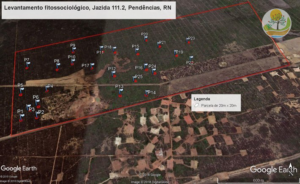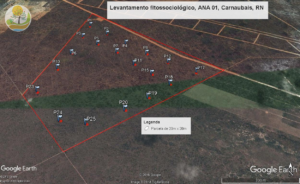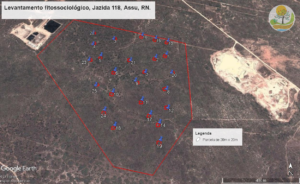
According to Alcalá et al. (2006), a floristic inventory provides a list of species that may be used, for example, in programs aiming to recover riparian forests and adjacent areas, important to the conservation of water resources.
According to Pessoa et al. (2009), floristic data has obvious importance, since from the identification of plant species in a specific area it is possible to verify the taxonomic structure and the conservation status of the specific domain. Which helps to understand the ecological relationships between vegetation and other biotic components, as well as its comparison to other areas (floristically similar or not).
Phytosociology is a branch of Plant Ecology widely used to give a quantitative-qualitative diagnosis of vegetal formation (ALCOFORADO-FILHO, SAMPAIO, and RODAL, 2003). Martins (1989) defines phytosociology as an ecology that quantifies vegetal communities, involving inter-specific relationship of plant species in space and time, in other words, it is a quantitative science for floristic composition, structure, performance, dynamics, distribution, and environmental relations of plant community, with a fundamental base in the plant taxonomy, with narrow relation with the phytogeography and forest sciences.
The study of phytosociology provides information about the community structure of a certain area and possible relations between species or groups of species, besides expanding our knowledge about woody native vegetation of different structures, evaluating instantly many vegetation structures, such as: frequency, density, and species dominance (SILVA et al., 2002).
Data collection follows this protocol:
- Inclusion criteria: perimeter at ground level (PGL) ≥ 10 cm, and height (H) ≥ 1 m
- Measurement of PGL and H of each registered plant in the plot
- Botanical identification of every plant
- Plots: 20 m x 20 m (400 m²)
- Build a graph of the minimum area for representativeness verification
- Floristic investigation to register the species that are present in each plot, and also in random walks outside plots:
- Calculation of basic structural parameters: absolute density (DA), relative density (DR), absolute dominance (DoA), relative dominance (DoR), absolute frequency (FA), relative frequency (FR), base area, Value of Importance Index (IVI), and Coverage Value Index (IVC) according to Mueller-Dombois and Ellemberg (1974)
- Estimation of floristic diversity and Evenness (Shannon-Wiener index (H’) and Pielou index, respectively).
Studied areas
The team designated to proceed the floristic and phytosociology inventory within the Projeto Caatinga worked in three different areas located in the cities of Assu, Pendências, and Carnaubais, state of Rio Grande do Norte, Vale do Assu (Assu Valley), Oeste Potiguar mesoregion, and in the Costa Branca area (coast area).

Distribution of 25 plots (20 x 20m) for phytosociology investigation nearby the Jazida 111.2, in Pendências-RN, Brazil.

Distribution of 25 plots (20 x 20m) for phytosociology investigation nearby the Base de poço ANA 01, in Carnaubais-RN, Brazil.

Distribution of 25 plots (20 x 20m) for phytosociology investigation nearby the Jazida 118, Assu-RN, Brazil.
References
- ALCALÁ, M.; FRANCESCHI, N. C. S.; STRANGHETTI, V. Florística de trechos de matas ciliares do ribeirão Borá e ribeirão Cubatão, Potirendaba – SP. Rev. Inst. Flor., São Paulo, v. 18, n. único, p. 79, 2006.
- ALCOFORADO-FILHO, F. G.; SAMPAIO, E. V. S. B.; RODAL, M. J. N. Florística e fitossociologia de um remanescente de vegetação caducifólia espinhosa arbórea em Caruaru, Pernambuco. Acta bot. bras., v. 17, n. 2, p. 287-303. 2003.
- MARTINS, F.R. Fitossociologia de florestas no Brasil: um histórico bibliográfico. Pesquisa série Botânica, São Leopoldo, v.40, 1989.
- Mueller-Dombois D, Ellenberg H. Aims and methods of vegetation ecology. New York: John Wiley & Sons; 1974.
- PESSOA, L. M. et al. Flora lenhosa em um fragmento urbano de floresta atlântica em Pernambuco. Revista de Geografia. Recife: UFPE – DCG/NAPA, v. 26, n. 3, 2009.
- SILVA, L. O. et al. Levantamento florístico e fitossociológico em duas áreas de cerrado no parque estadual da serra de Caldas Novas – GO. Acta bot. bras., v. 16, n. 1, p. 43-53, 2002.
